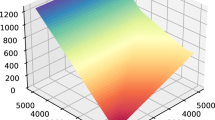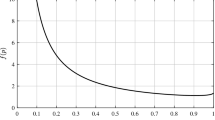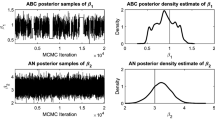Abstract
In statistical practice, it is quite common that some data are unknown or disregarded for various reasons. In the present paper, on the basis of a multiply censored sample from a Pareto population, the problem of finding the highest posterior density (HPD) estimates of the inequality and precision parameters is discussed assuming a natural joint conjugate prior. HPD estimates are obtained in closed forms for complete or right censored data. In the general multiple censoring case, it is shown the existence and uniqueness of the estimates. Explicit lower and upper bounds are also provided. Due to the posterior unimodality, HPD credibility regions are simply connected sets. For illustration, two numerical examples are included.
Similar content being viewed by others
Refrences
Ali Mousa MAM (2003). Bayesian prediction based on Pareto doubly censored data. Statistics 37:65–72
Arnold BC, Press SJ (1983). Bayesian inference for Pareto populations. J Econom 21:287–306
Arnold BC, Press SJ (1986). Bayesian analysis of censored or grouped data from Pareto populations. In: Goel P, Zellner A (eds). Bayesian Inference and Decision Techniques. North Holland, Amsterdam, pp 157–173
Arnold BC, Press SJ (1989). Bayesian estimation and prediction for Pareto data. J Am Statist Assoc 84:1079–1084
Balakrishnan N (1990). On the maximum likelihood estimation of the location and scale parameters of exponential distribution based on multiply Type II censored samples. J Appl Statist 17:55–61
Chan LK (1970). Linear estimation of the location and scale parameter of the Cauchy distribution based on sample quantiles. J Am Statist Assoc 65:851–859
Cheng SW (1975). A unified approach to choosing optimum quantiles for the ABLE’s. J Am Statist Assoc 70:155–159
Curtis HB (1944). A derivation of Cardan’s formula. Am Math Monthly 51:35
Dyer D (1981). Structural probability bounds for the strong Pareto law. Can J Statist 9:71–77
Eubank RL (1981). A density-quantile function approach to optimal spacing selection. Ann Statist 9:494–500
Fei H, Kong F, Tang Y (1995). Estimation for two-parameter Weibull distribution and extreme value distribution under multiply Type II censoring. Comm Statist A 24:2087–2104
Fernández AJ (2006). Bounding maximum likelihood estimates based on incomplete ordered data. Comput Statist Data Anal 50:2014–2027
Fernández AJ (2007) Bayesian estimation based on trimmed samples from Pareto populations. Comput Statist Data Anal (in press)
Geisser S (1984). Predicting Pareto and exponential observables. Can J Statist 12:143–152
Geisser S (1985). Interval prediction for Pareto and exponential observables. J Econom 29:173–185
Kaminsky KS (1973). Comparison of approximate confidence intervals for the exponential scale parameter from sample quantiles. Technometrics 15:483–485
Kong F, Fei H (1996). Limits theorems for the maximum likelihood estimate under general multiply Type II censoring. Ann Inst Statist Math 48:731–755
Lwin T (1972). Estimation of the tail of the Paretian law. Scand Act J 55:170–178
Nigm AM, Hamdy HI (1987). Bayesian prediction bounds for the Pareto lifetime model. Comm Statist A16:1761–1772
Tiwari RC, Yang Y, Zalkikar JN (1996). Bayes estimation for the Pareto failure-model using Gibbs sampling. IEEE Trans Reliab 45:471–476
Tiwari RC, Zalkikar JN (1990). Empirical Bayes estimation of the scale parameter in a Pareto distribution. Comput Statist Data Anal 3:261–270
Upadhyay SK, Singh U, Shastri V (1996). Estimation of exponential parameters under multiply Type II censoring. Comm Statist A25:801–815
Zheng G, Gastwirth JL (2000). Where is the Fisher information in an ordered sample? Stat Sin 10:1267–1280
Author information
Authors and Affiliations
Corresponding author
Rights and permissions
About this article
Cite this article
Fernández, A.J. Highest posterior density estimation from multiply censored Pareto data. Statistical Papers 49, 333–341 (2008). https://doi.org/10.1007/s00362-006-0016-5
Received:
Revised:
Published:
Issue Date:
DOI: https://doi.org/10.1007/s00362-006-0016-5




